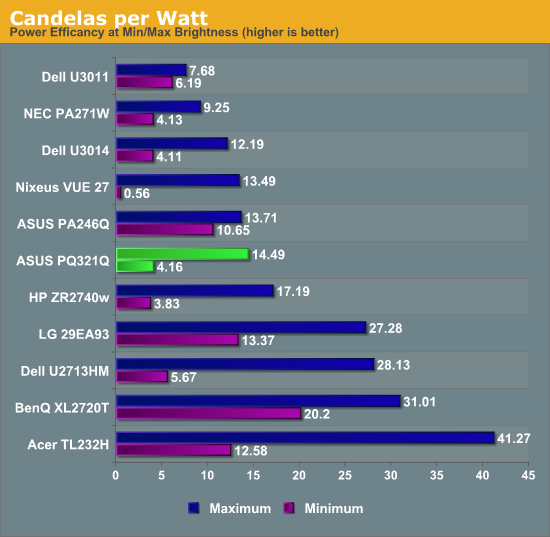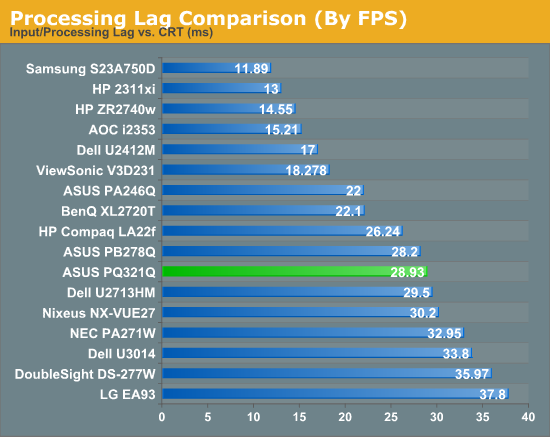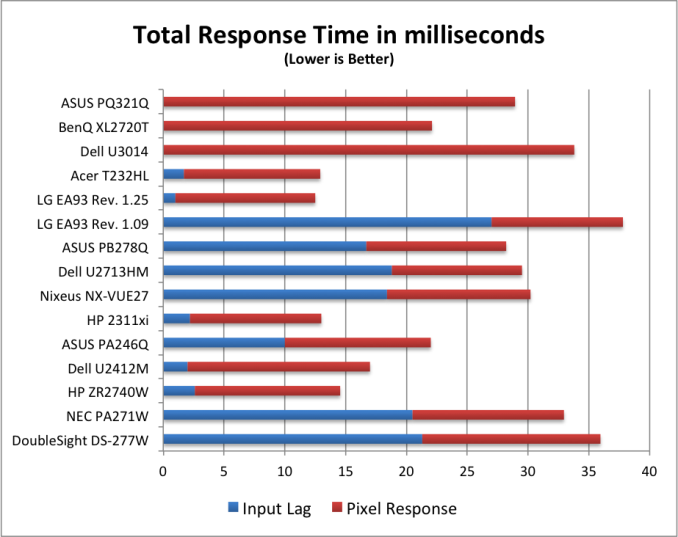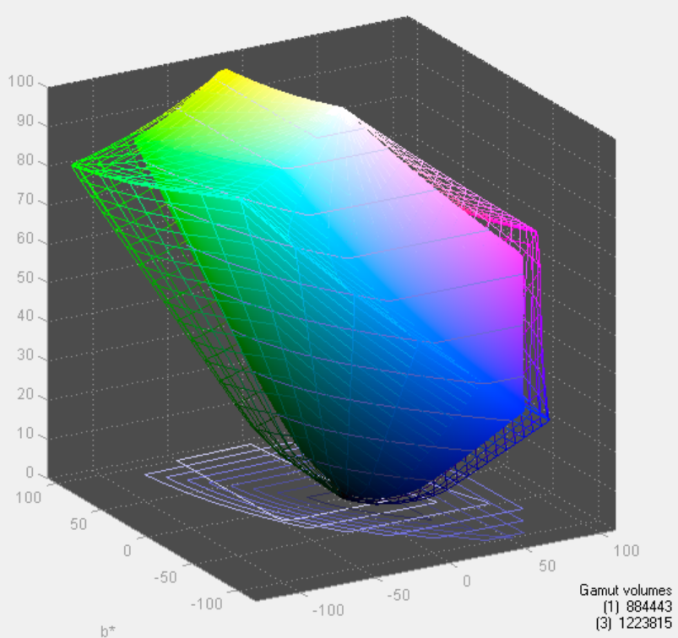ASUS PQ321Q UltraHD Monitor Review: Living with a 31.5-inch 4K Desktop Display
by Chris Heinonen on July 23, 2013 9:01 AM ESTUsing the updated metric for power usage, where I factor in maximum brightness and screen area and not just power usage, the ASUS PQ321Q falls right in the middle of the pack. For both maximum and minimum brightness it does OK but not incredible in comparison to other displays. With the greater transmission of IGZO I would have thought I might see better numbers from the ASUS, but I imagine power usage was very low on the list of concerns relative to other performance numbers.
Overall the ASUS PQ321Q draws a relatively average amount of power compared to other displays.


For testing input lag, I’m again reduced to using the Leo Bodnar lag tester over HDMI. This also means that the ASUS will have to scale the 1080p signal to be 2160p and fill the screen. Unlike before, I think this might be a more accurate test as many people will not be gaming at 2160p yet. Looking at the gaming numbers that our Ian Cutress found with a 4K display, you might want to run at 1080p for a little bit until setting up a 4x Titan rig becomes more affordable. Then again, if you can afford the ASUS PQ321Q, you might be buying a 4x Titan setup as well.
Back to the actual data, and the ASUS comes in at 28.93 ms of lag on average for the 3 measurement locations. This is better than the Dell U3014 monitor does, but slower than the BenQ XL2720T that is a native 1080p display. Given that you have scaling going on here, this actually is a pretty decent result I think.

Despite my GPU only being a GTX 660 Ti, I did try out a little bit of gaming on the ASUS. One question that was debated in Ian’s round-up was the necessity of MSAA at 4K resolutions. Measuring just now, I sit exactly 2’ away from the ASUS PQ321Q, with my eyes around dead center on the display. Turning on Half Life 2 (look, I’m not much of a gamer!), I can easily see the difference between no MSAA, 2x and 4x MSAA. The pixel density would need to be even higher, or I’d need to sit further away, for MSAA to not make a difference.
Without MSAA things still looked very sharp overall, but jagged lines are easy to spot if I look for them. You might be able to more easily get away with 2x or 4x instead of 8x MSAA, but you’ll want to have it enabled. Beyond that, the PQ321Q worked well for my casual gaming. Nothing recognized the display correctly at first, perhaps because of MST, but once in the game you can properly select the 3840x2160 resolution for it.
At the request of a commenter I'm adding some PixPerAn photos, trying to show best and worst case results. I've not used PixPerAn at all before, so feedback would be great. If I've done something wrong with it, I'll try to correct it ASAP.
Looking at the gamut, we see a value that indicates full sRGB gamut coverage. From our earlier images of the CIE diagram we know we don’t have full coverage of red, blue and magenta. It seems the extra green/yellow/orange section is large enough that we get a value that indicates a volume equal to the sRGB space, but some of that volume is an area outside of sRGB. It is close to the sRGB area, but not quite.


















166 Comments
View All Comments
peterfares - Wednesday, July 24, 2013 - link
It's pretty easy to tell why they're getting 3200x1800 monitors. The super high DPI at that size and distance is unnecessary, but it has one HUGE advantage: You can use 200% scaling. That means things that aren't DPI-aware can run at standard DPI and then be doubled in width and height. This avoids the fuzzy effect like this article was complaining about when you use 150% on unsupported programs. With 200% scaling they'll look just like they do on a standard DPI display, not worse which is when happens when you use a decimal scaling factor.APassingMe - Tuesday, July 23, 2013 - link
I'm concerned since you mention the "low" contrast numbers. The last time I checked, any number over 100:1 was due to software enhancements and was equivalent to a higher quality contrast that racked lower due to not having much or any software enhancement meaning that the current contrast numbers thrown around are just a bunch of marketing jumble.So wouldn't it be better to just measure the contrast with a 3rd party tool? As the numbers provided from the manufacture are pretty much a product of fiction + the marketing team, just my two cents
APassingMe - Tuesday, July 23, 2013 - link
my bad, that's ranked* not rackedcheinonen - Tuesday, July 23, 2013 - link
The number on the specs page is the one that the manufacturer quotes. In the test results you can see what we actually found. Desktop LCD numbers far fall behind what is possible with plasma TVs and the best LCOS projectors, or ever rear array LCD TVs. 100:1 would be insanely low and a poor design. Desktop LCDs are capable of 1000:1, without any sort of trick.APassingMe - Tuesday, July 23, 2013 - link
I see, I could of been confusing the data with that from projectors; regardless I'm glad the test results are posted regardless as the definition of "contrast" can be a varying thing. Thanks for the swift responsefreedom4556 - Tuesday, July 23, 2013 - link
Yeah, you were definitely thinking of those "dynamic" contrast ratios that are complete BS. They are usually more in the 100,000:1 or 1,000,000: range, though. Completely unreasonable.sheh - Tuesday, July 23, 2013 - link
The official specs table lists the contrast as "800:01:00".cheinonen - Tuesday, July 23, 2013 - link
Great, I'll fix that since apparently Excel decided to change that to a time or something else. But it's fixed now.Streetwind - Tuesday, July 23, 2013 - link
31.5 inch is still too big for me. I'm not puttin anything over 24" on my desk. I've tried it, and I just can't like it.Unfortunately it seems that vendors are producing either tiny portable screens or gigantic TVs, and no real midsize desk monitors anymore. At least not outside the same old 1080p that we've been getting for the past 4 years.
cheinonen - Tuesday, July 23, 2013 - link
Well rumors are that Dell might be coming out with a 24" UHD display using a panel from LG. If that happens then I'll be happy to review that as well.